Built-in wardrobe in the hallway: design, types and placement
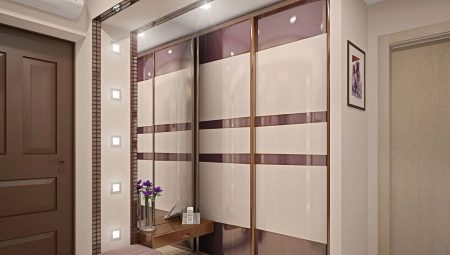
The planning and arrangement of each hallway should be taken seriously. A well-equipped entrance hall is the face not only of the entire apartment, but also of its owner - it sets the tone for the design of the house and gives an idea of the tastes of the apartment owner. This article will discuss the design, types and methods of placing built-in wardrobes, which are one of the main design elements of modern hallways.
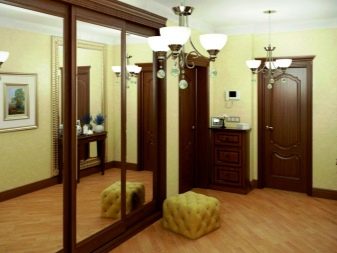

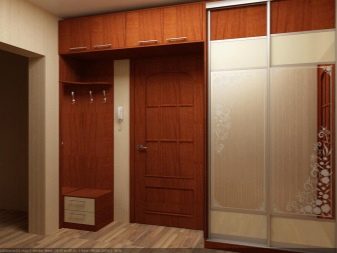
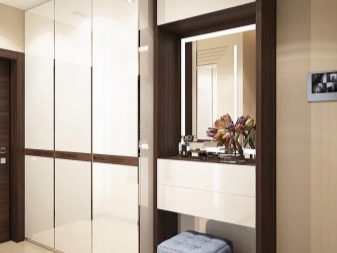
Peculiarities
To understand the main features and benefits of built-in wardrobes, it is worth turning to the main advantages of such furniture.
- Compactness of designs. The huge number of shapes and sizes, as well as the possibility of making such furniture to order, allows you to use the space intended for the cabinet with maximum benefit.
- Variety of designs. One of the main advantages of built-in wardrobes is that they can be made in any design and size. Therefore, each owner can find an ideal option for his apartment according to the interior of the hallway or premises.
- Roominess. Modern built-in wardrobes are designed in such a way that it is convenient to place clothes, accessories and household appliances. Some models have special compartments for household appliances, shoes and even an ironing board.
- "Invisibility". Modern built-in wardrobes are designed so skillfully that they literally merge with the wall or hallway in the hallway.Most of them have no walls, no ceiling or floor, so they fit perfectly into any interior.
- Durability. No matter the materials, built-in wardrobes usually last much longer than regular furniture. Placing such a cabinet in a special niche protects it from accidental mechanical damage.
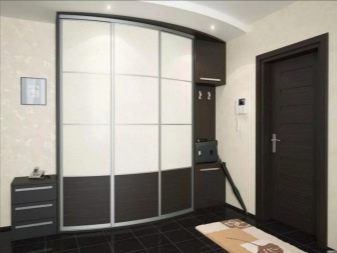
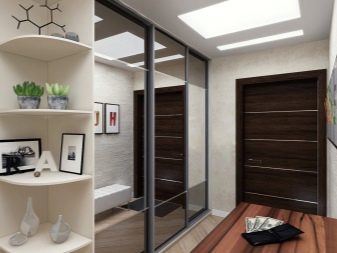


Despite the fact that most of the buyers do not attribute serious problems to built-in wardrobes, they still have one drawback. If you want to move or move furniture to another place, the likelihood that there such a cabinet will look harmonious and fit into the space provided is extremely small.
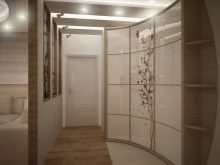
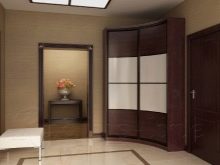
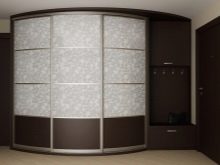
Types of structures
Depending on the type of construction, location, and design, there are several types of built-in wardrobes. Their features can be found below.
- Built-in or standard wardrobe. This is the most common and spacious option in the hallway. As a rule, it has no walls, no floor or ceiling. Such a wardrobe is usually built into a prepared space, which can be an ordinary closet or niche - now they are found in many new buildings. Opening, sliding or sliding doors and shelves are responsible for mobility. The key feature of such cabinets is that they are made as high as possible, often leaving no more than 15 cm of free space to the ceiling of the room.

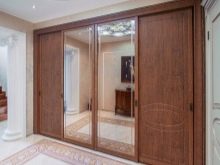
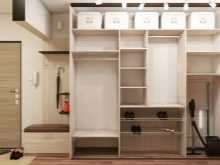
- Corner option. By design, it can be either purely built-in, or with walls and a ceiling. Unlike the options located above, this design allows you to take up less space, but at the same time it is not inferior to the spaciousness of the standard equipment. As a rule, the front or front of the cabinet is located at a wide angle for a smooth transition to the walls of the room.
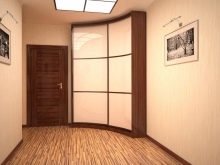
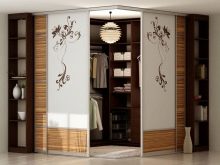
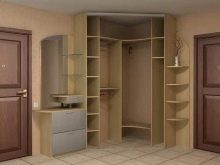
- Rounded version. Some sellers also like to call it radial or radial. This is one of the most expensive and least common options in Russian apartments. A distinctive feature of such a built-in wardrobe is a rounded convex or wavy shape. The shape of the cabinet is also repeated by the sliding doors. As a rule, these built-in wardrobes are bought to complement some specific interior in the apartment.
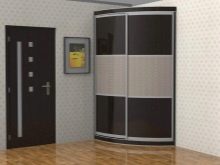
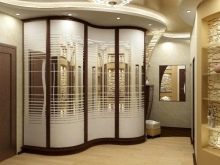
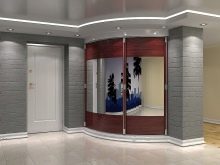
- Louvered built-in wardrobes. This is not the most common option on the Russian market - the first analogues were designed in countries with hot and humid climates. The special design of the cabinet made it possible to provide good ventilation inside the furniture and prevent sunlight from entering. Thanks to this approach, there was no chance that the clothes would become damp, deformed or get an unpleasant odor.
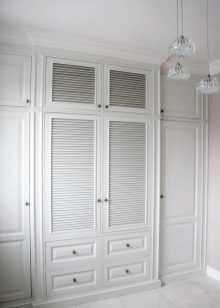

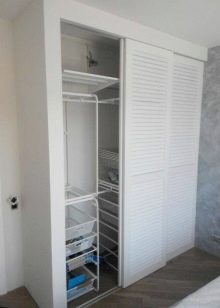
- Hinged built-in wardrobe. As a rule, these are completely ready-made cabinet models, manufactured strictly for a specific niche. The key feature of these wardrobes is that they can be opened or hinged, rather than sliding doors on wheels like in most built-in wardrobes. Most often, these built-in wardrobes are used exclusively as a dressing room and are not intended for storing household appliances.
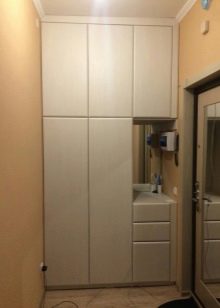

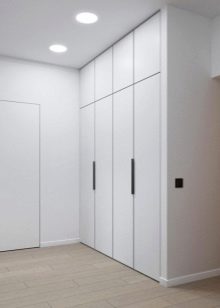
Each of the presented varieties, with a competent layout, can be used in any house: panel, block or private.
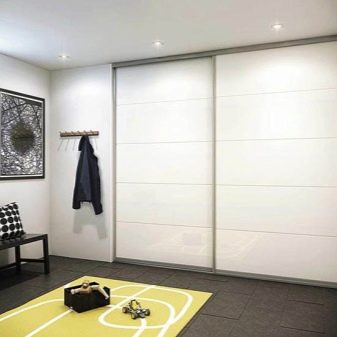
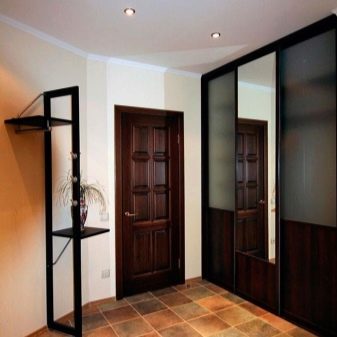
Manufacturing materials
For the durability, beauty and functionality of any built-in wardrobe, it is not only the design that is responsible, but also the material of manufacture itself. Today, the following materials are most often used in the manufacture of built-in wardrobes: MDF, chipboard, fiberboard and wood. The pros and cons of each of these materials will be discussed below.
- MDF. One of the most common materials for the manufacture of built-in wardrobes in the hallway. This material is wood fiber boards, which are made from thermally treated wood fibers glued with polymer substances.The advantages of the material are increased strength, as well as flexibility, durability and resistance to low temperatures and moisture. Due to the flexibility and strength of such materials, they can be used for the manufacture of a wide variety of cabinets in terms of design and construction. Models of built-in wardrobes are considered environmentally friendly, therefore, the cost for them is much higher than for models made of other materials.
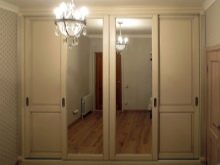
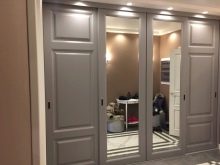
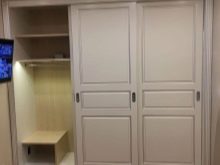
- Chipboard. It is the most popular and cheapest material in the manufacture of any furniture. It is a compressed wood shavings treated in small quantities with formaldehyde resin. The unambiguous advantages of such a material are its low cost, durability, as well as the ability to perform in a wide variety of color shades.
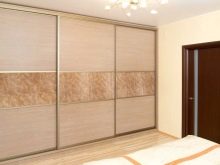
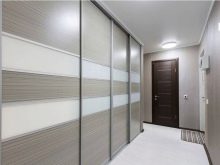
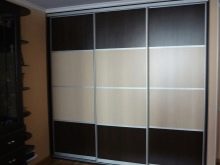
- Fiberboard. One of the cheapest materials in the manufacture of furniture due to a heterogeneous and cheap component. As a rule, fiberboard slabs are wood waste compressed and treated with paraffin and resins. Despite the high prevalence around the world, such furniture is considered the most substandard - over time, fiberboard plates are deformed due to moisture or high temperatures.
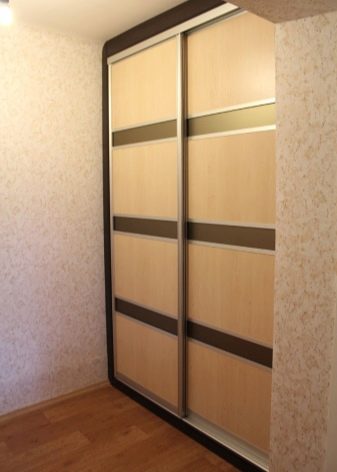

- Wood. Natural wood is also actively used in the manufacture of furniture, including built-in wardrobes. Such designs are environmentally friendly, durable and able to maintain their appearance for more than a dozen years. For the manufacture of built-in wardrobes, either wooden lining (or thin boarding) or planed board is most often used. Despite the described advantages, natural wood furniture has its disadvantages: increased weight, as well as low resistance to high humidity.
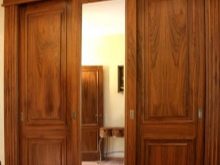
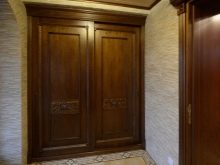
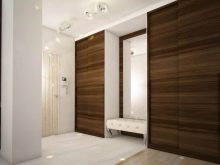
What are the sizes?
When choosing any furniture, be it a bed, a curbstone or an ordinary kitchen table, any owner, first of all, pays attention not to the design of the furniture, but to its dimensions. The harmony of the entire interior in the room depends on the size of a certain piece of furniture. Experienced owners, if they want to buy a certain model of built-in wardrobe for an apartment, order or create with their own hands a rough draft of the room's design. This approach allows them to competently plan the space allocated for furniture and imagine how this or that piece of furniture will look in a particular interior.
There are several types of built-in wardrobes in the hallway, depending on the height, depth and width.
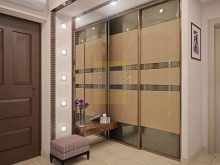
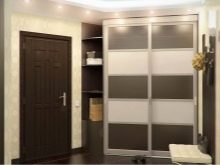

Standard
Despite the name of the variety, there is no standard in dimensions for the manufacture of built-in wardrobes. However, there is a list of specific recommendations that should be heeded when purchasing such furniture.
- Basement level. The optimum height is about 10 cm.
- Overall height of the model. Depending on the height of the ceiling in the room (usually up to 2.5-2.7 m), it can vary from 2.2 to 2.5 m.
- Width. Depending on the size of the room, it can be from 1.5 to 3 m.
- Depth. This indicator is in the range from 45 to 60 cm. Most often there are built-in wardrobes in the hallway with a depth of 50 cm.
- Shelf width. Shelves up to 100 cm wide are allowed, but 55-60 cm is considered the best option.

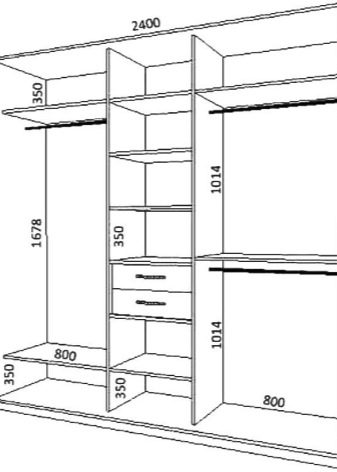
It should be understood that the dimensions presented above relate to apartments and rooms of precisely standard sizes. Do not forget that in each individual case, the choice of a built-in wardrobe in the hallway should be treated individually. For example, the concept of a standard in the size of furniture for different manufacturers can mean completely different numbers and sizes.
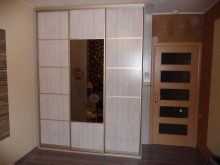
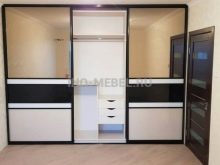
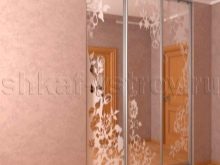
"Mini"
This version of the built-in wardrobe is designed exclusively for small apartments with low ceilings and a small amount of free space. The model received this name due to the non-standard, in terms of height and depth, dimensions relative to other types of built-in wardrobes in the hallway.
In this case, extremely close cooperation of the customer with the contractor is assumed, since it is here that every centimeter can be decisive.

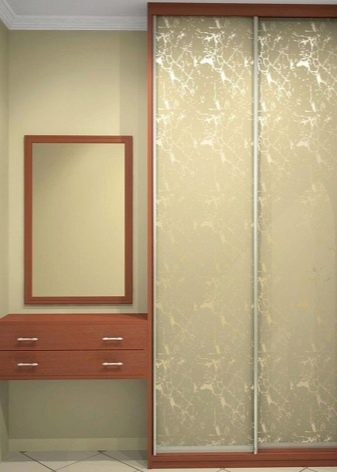
Built-in wardrobes of the "mini" type in the hallway have the characteristics described below.
- Width. On average, it should be about 1 m. The width of doors (sliding or swing) is from 45 to 50 cm. It is believed that if the sliding doors are narrow, the integrity of the entire cabinet will suffer. In this case, it is recommended to refer specifically to the swing cabinet options.
- Depth. The depth of the cabinet itself is up to 35 cm, while it should be borne in mind that the actual size of the shelf itself will be even smaller - on average up to 25-30 cm. This is due to the width of the doors themselves - in the case of swing doors, it is slightly smaller.
- Height. Unlike standard models, there are no height restrictions in this version. Here, as miniature built-in wardrobes, there can be both very low options (up to 1.5 meters), and models up to the ceiling.
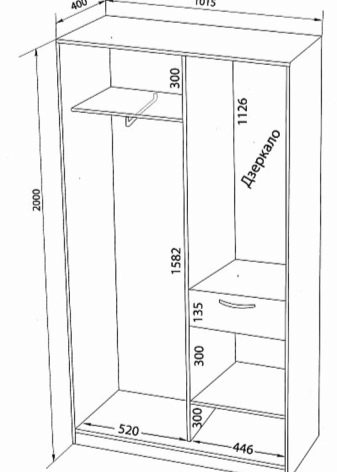
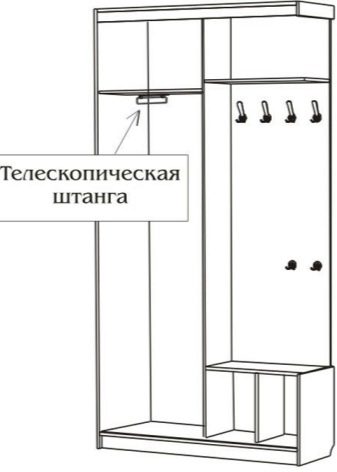
"Maxi"
The presented version of the built-in wardrobe shows itself perfectly in large apartments with spacious hallways. Most often it is bought by owners with large families or a large number of seasonal clothes - such built-in wardrobes are often used as dressing rooms.
- Depth. If in miniature models of built-in wardrobes the optimal depth is considered to be 35-40 cm, then in models of the "maxi" type this value more than doubles (up to 90 cm). Despite this, most of the owners stop at models that offer shelves with a depth of 60-70 cm - this is the average length of an adult human hand. Usually built-in wardrobes with a depth of more than 80 cm are equipped with pull-out shelves that simplify the process of using the furniture.
- Height. Despite the name, the height of such models does not differ much from the height of standard cabinets and rarely exceeds 270-280 cm. Everything is explained by the inconvenience of using built-in cabinets at high heights.
- Width. Usually, chipboard sheets are used as the material for the manufacture of built-in wardrobes of this type. Since a standard chipboard sheet is limited to 280 cm, the width of the built-in wardrobe itself cannot be larger. In rare cases, manufacturers resort to special partitions to increase the size of furniture. In the case of using natural wood in the manufacture of cabinets of the "maxi" type, the width of the model is limited only by the request of the customer.
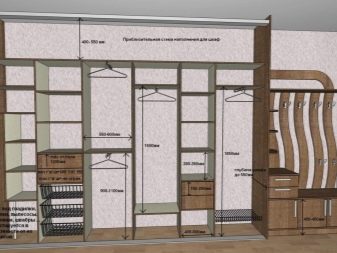
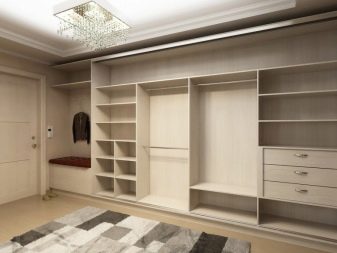
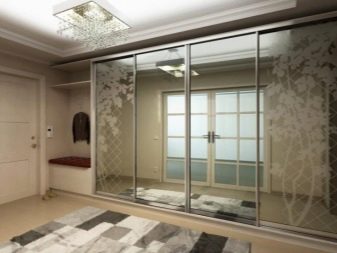
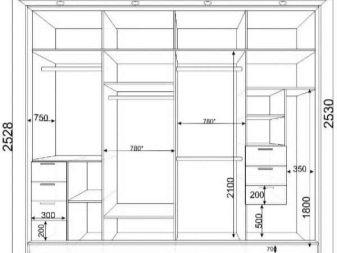
Filling and additional elements
As soon as the buyer has chosen the dimensions and design of the future built-in wardrobe in the hallway, the components filling it should be carefully considered.
The functionality of the entire cabinet depends on the content (quality of shelves, partitions, depth of compartments).
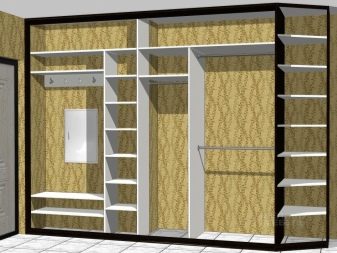
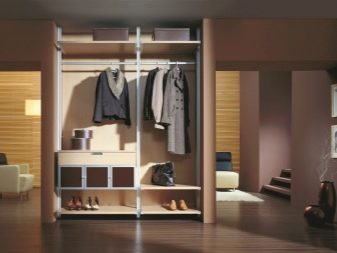
All built-in wardrobes can be conditionally divided into several internal compartments or zones. Each of them is designed to store certain items of clothing or appliances. You should understand in more detail the features of each such section.
- Main zone. As a rule, such an area is used exclusively for storing outerwear items. It is usually divided into two more: the upper zone, which is equipped with a barbell or crossbar, hangers with outerwear are attached to it, and the lower zone. The latter is equipped with several shelves or drawers in which accessories and additions to clothes are stored: gloves, shawls, scarves, hats. In large built-in wardrobes, the main area can be conditionally subdivided into several separate bars or sections for business, casual, street or sportswear.
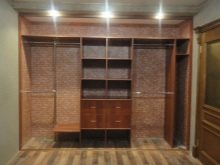
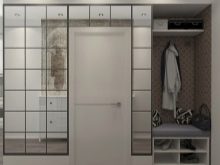
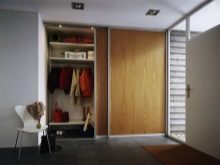
- Upper zone. As a rule, it is one continuous long, but not particularly large shelf. Most often, it is used to store items of clothing that are rarely used or left for the next season. You can also successfully store situational elements here - umbrellas, scarves or hats.Such a shelf can also serve as a kind of mezzanine.

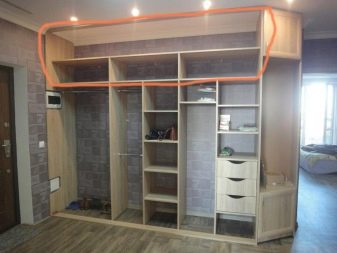
- Lower zone. It is located at ankle level and is presented in the form of long and low shelves with several levels of sections of different sizes. Inside these sections, shoes are stored for different seasons or for different family members. In cheaper versions of built-in wardrobes for the hallway, shoes are not stored in special sections or shelves, but simply placed on the floor.
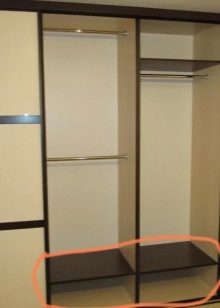
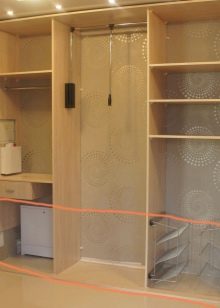
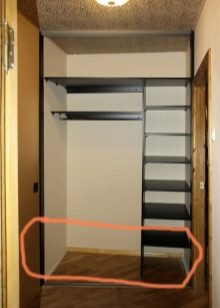
- Additional area. This section can be either continuous or multi-section and serve as a place for storing medium-sized or large-sized household appliances, small and household items, detergents, jewelry and accessories, as well as casual and sportswear.
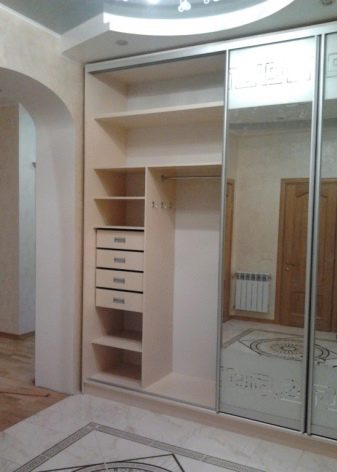

The standard model of the built-in wardrobe in the hallway should have a number of elements for the convenient use of furniture.
- Shelves. It is desirable that they be of different sizes and lengths.
- Clothes hanger bars. Fits in models with a depth of at least 50 cm.
- Hangers. As usual for rails, and end-type hangers when it comes to narrow models of built-in wardrobes.
- Rectangular nets for shoes or netting type "netting".
- Hooks on the walls (at least 2-3 pieces). They are used both for placing clothes and for accessories (umbrellas, gloves or hats).
- Pantograph. It is an indispensable tool in large, multi-purpose wardrobes where clothes are placed above head level. Allows you to easily lower the boom and control the shelves.
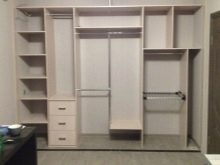
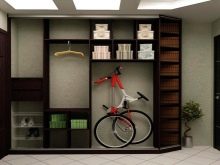
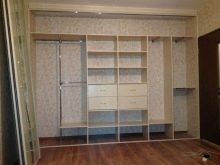
Appearance
The appearance of furniture often depends not on design, but on the material that was chosen for its manufacture. As mentioned above, chipboard, MDF, fiberboard or natural wood are used for the manufacture of built-in wardrobes. Most often, built-in wardrobes are made of chipboard or MDF. The first option is much cheaper than the second.
However, the second is more flexible, which allows you to create the most extraordinary cabinet models with it.
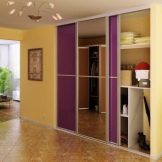
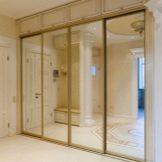
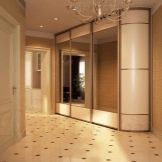
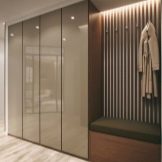
Each type of built-in wardrobe for the hallway is divided into two parts: cladding and frame. If the frame itself can be made only from the materials presented above (chipboard, MDF, fiberboard or natural wood), then a variety of materials can act as cladding.
- Particleboard and MDF. This is the cheapest option for cladding in built-in wardrobes. To give the materials a pleasant appearance, paint, varnish or folia are often used.
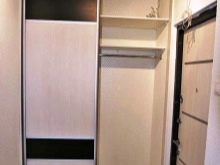
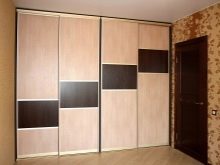
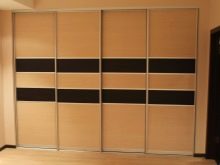
- Mirror cladding. This option has been recognized as a classic on the Russian market for several years. Each owner wants a large full-length mirror in his hallway, and this function is perfectly performed by mirrored sliding doors. The disadvantage of such doors is that the mirror gets dirty quickly under the constant influence of hands. Also worth noting is the fact that solid mirror doors are heavy and fragile. It is for this reason that experienced owners advise choosing options with partial glazing of the cabinet, where the mirror is at a certain (usually average) level, and the frame itself is made of chipboard or aluminum.


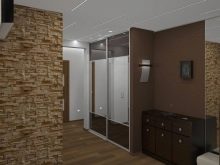
- Glass cladding. This is not a particularly common option due to the fragility of individual components. Most often, opaque or processed glass is used here, which partially or completely covers the entire facade.
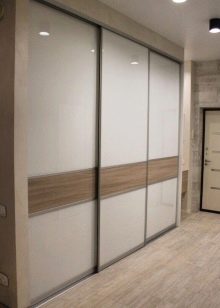
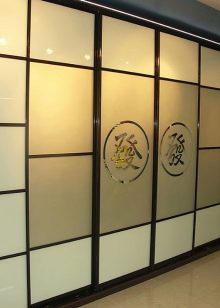
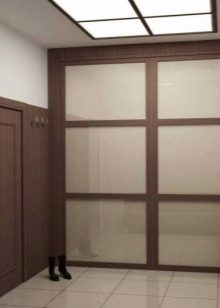
- Photo-facade. This is a popular option among owners of glass-lined built-in wardrobes. In this case, a film with some kind of pattern is placed on the glass (most often these are flowers or abstract patterns). On top of the film, the facade is varnished to fix the result and prevent damage to the film.
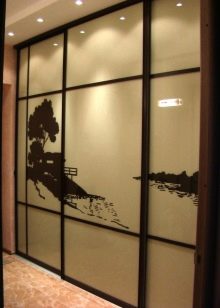
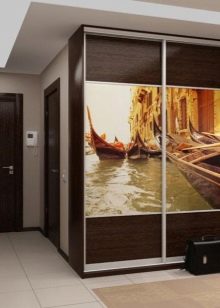
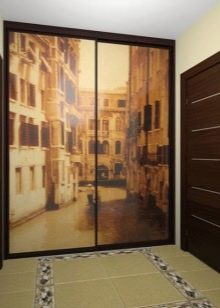
How to choose?
When choosing built-in wardrobes in the hallway, you should pay attention to a number of recommendations. They will help you choose the right option for the built-in wardrobe, which will not only be beautiful, but will also last for many years.
- Accurate calculations. Experienced owners strongly advise drawing up projects in advance with precisely measured dimensions of the available free space. If a person is not able to accurately determine the correct dimensions and cannot draw up an approximate design project for the hallway, then he can always contact a specialist.
- Facade. The facade or cladding is the main element of the future cabinet. If its appearance practically does not depend on the frame, then the facade is responsible for the general appearance of the whole hallway. For example, if the lining of the cabinet is made of a mirror, this will visually enlarge the corridor and make it more spacious in the eyes of the family and guests.
- Interior. It is worth paying attention to the overall design and interior of the apartment. For example, a wooden version of a built-in wardrobe with convex elements and pastel colors will fit more into a classic interior. Mirror options for cabinets or swing cabinets with neutral tones (white, black) will perfectly fit into the interior of the minimalism style.
- Furniture color. Particular attention should be paid to the colors of the future cabinet. Experts recommend turning to darker colors in the hallway - they visually reduce the size of the furniture, making it laconic and compact. The options for cabinets with a dark wood texture look good - it gives the appearance of the hallway more coziness and warmth.
- Prices and reviews. Do not forget about the cost of buying and installing certain models - this is also an important point. Additionally, you need to pay attention to customer reviews of certain cabinets - this will give a person an idea of what can be expected in the future from a particular model.
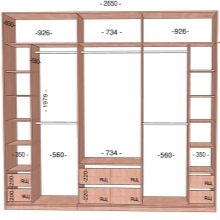
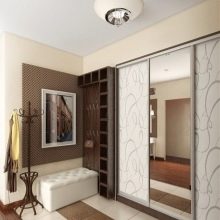
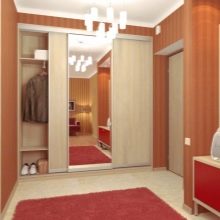
Where is it better to place?
- Cabinet in a niche (hidden version). This is the most common and most successful accommodation option. In this case, the entire cabinet is placed in free space, without forming sharp and protruding corners and surfaces. Most often, it is the built-in rather than the finished version that is used here, there are no walls, floor and ceiling, and the shelves and sections are attached directly to the back wall of the niche. This option applies to niches with a depth of up to 60 cm. If we are talking about niches with a depth of more than 1 m, you can equip a built-in wardrobe in such a way that there is free space behind its doors for a standing person.
Thus, you can create a complete dressing room.
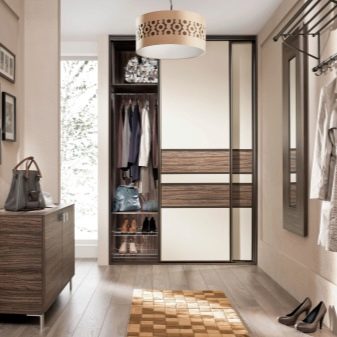
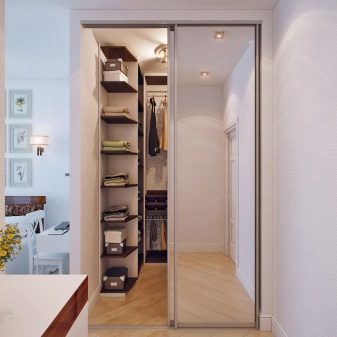
- Built along the wall with an emphasis on the corner. In almost all modern Russian apartments, right after entering the apartment there is a free area, which is used by many for a built-in wardrobe. In this case, a hybrid version is used - here the walls are only on the side of the front door. The advantage of this type is that it does not take up extra space and does not interfere with the passage into the apartment or rooms.

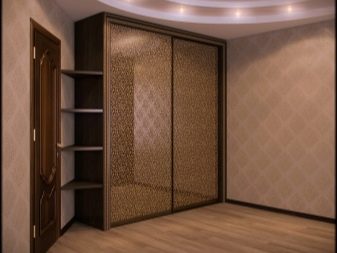
- Built sideways in the corner. This is a fairly popular option for placing a closet in large apartments and spacious hallways. It visually takes up much more space than other varieties. In this case, a hybrid version is also used, where the walls of the cabinet are present, but the ceiling and floor may be missing. This option is not particularly popular due to the difficulty of controlling the doors at the corner joint.
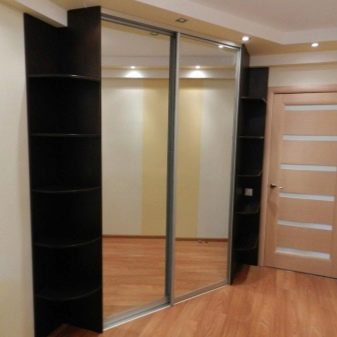
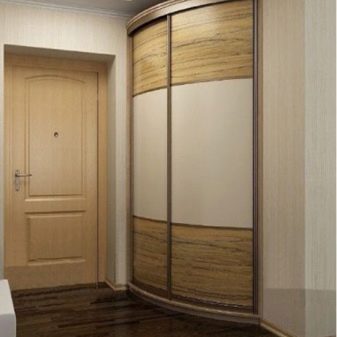
- Built around the front door. Not very popular, but very functional and compact type of cabinet for those who want to make the most of all the space in their apartment. This variety forms a kind of arched or U-shaped structure around the front door. The side compartments store clothes, the lower compartments store shoes, and the upper ones serve as mezzanines.
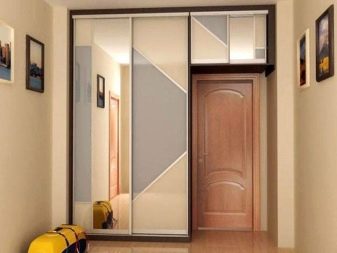
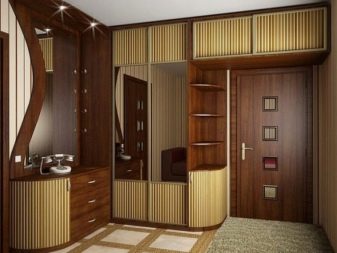
- Built under the stairs. This option is used exclusively in private homes and is intended to make the most of the free space. In this case, the dimensions and shapes of the cabinet completely repeat the angle and height of the stairs. Most often, it is the retractable versions of shelves or a cabinet with open shelves and a back wall (like a rack) that are used here.
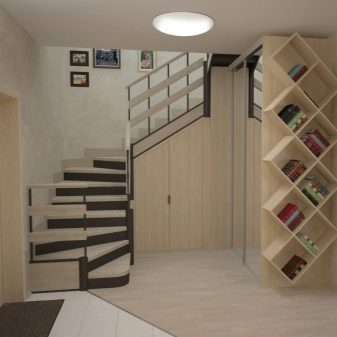
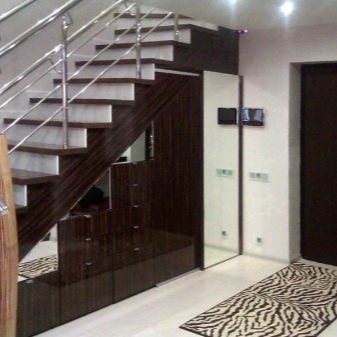
Successful examples in the interior
Check out some good ideas below. placement of varieties of built-in wardrobes in the design of different hallways.
- The mirrored built-in wardrobe in the hallway fits perfectly into the interior of the corridor.
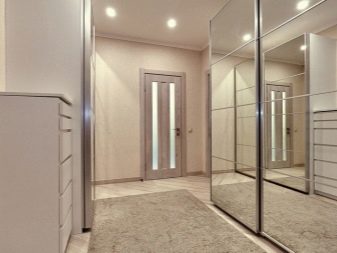
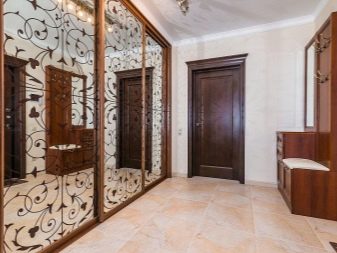
- Corner built-in wardrobe harmoniously matches the design of the hallway.
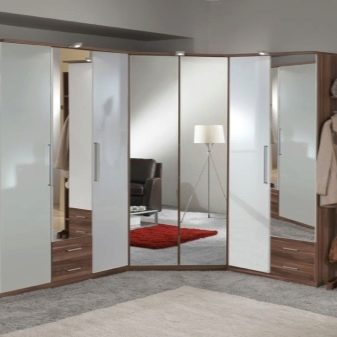
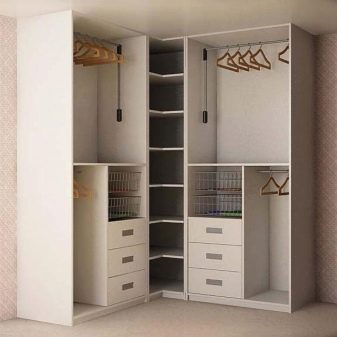
- The interesting design of the radial built-in wardrobe will be remembered by guests for a long time.
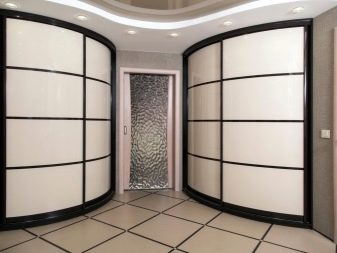
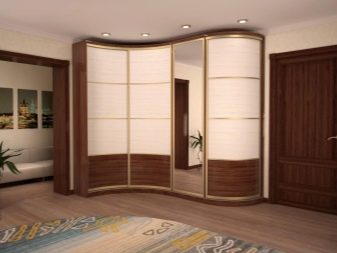
- The built-in wardrobe under the stairs looks quite interesting and takes up a minimum of space in the hallway.
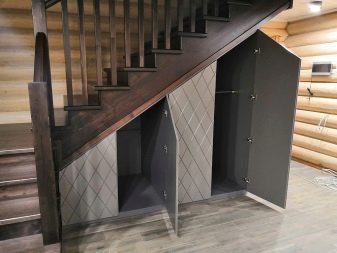
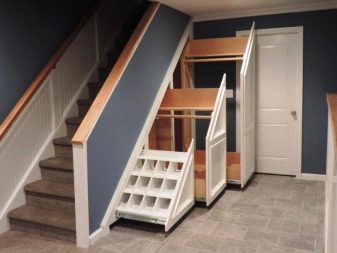
For an overview of the built-in wardrobe for the hallway, see the video below.








